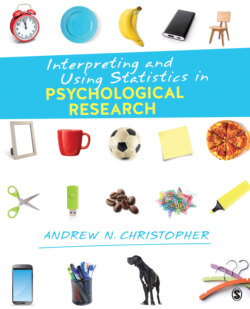Читать книгу Interpreting and Using Statistics in Psychological Research - Andrew N. Christopher - Страница 18
На сайте Литреса книга снята с продажи.
Gambler’s fallacy
ОглавлениеOur second obstacle in understanding connections between events is closely related to the illusory correlation. The gambler’s fallacy is a thinking tendency that involves making a connection between prior outcomes and future outcomes when those outcomes are independent of each other (Nickerson, 2002). Let’s discuss some examples of the gambler’s fallacy.
Gambler’s fallacy: tendency to think that two mutually exclusive outcomes are somehow related.
After graduating from high school in Texas, I went to college in a small town in Florida. At that time, Texas did not have a lottery, but Florida did have one. So, a few weeks after starting college, I decided to buy a lottery ticket for the weekly drawing on Saturday nights. I did so each week during my first year in college. By late April of that school year, I had won nothing. I figured I was overdue to win something, so instead of buying one ticket that week, I bought five tickets. After all, with such a long losing streak, I was bound to win something at some point, right? If you are shaking your head at my logic, good for you. My logic is an example of the gambler’s fallacy. That is, I thought that a previous outcome (not winning lottery money) was somehow connected to a future event (likelihood of winning lottery money) when in fact there was no connection between the prior outcome and the future outcome.
To take another example of the gambler’s fallacy, consider the game of roulette. The dealer spins the wheel and a ball lands in one of the slots, each of which has a number and color associated with it. Players can bet on what color the ball lands on (red, black, or green), which specific number or set of numbers (e.g., evens or odds) the ball lands on, and so on. I have this game, and I decided to spin the wheel 50 times. Here are the outcomes of those spins. The color of the number represents whether it is a “red” or “black” number (or a “gray” number in a few outcomes). The first column is the first 10 spins, the second column is the second 10 spins, and so on.
“Red number outcomes appear in blue font”
Look at the first 10 spins. There were 8 black numbers that came up. So, on the 11th spin, it would just seem I was overdue for a red number. But of course, the 11th outcome had nothing to do with the first 10 outcomes, and indeed, the 11th outcome was another black number. The odds of the ball landing on a red number or a black number are the same for the 12th spin as they were for each of the first 11 spins.
You might be thinking at this point that these examples of the gambler’s fallacy involve small numbers of observations (e.g., one spin of the roulette wheel). And indeed, you are correct. As we said at the outset of this section of the chapter, these issues in statistical thinking are closely related. With the gambler’s fallacy, it is more likely to manifest itself in our thinking when we have only a limited number of observations available. Take a look back at the outcomes of my 50 spins of the roulette wheel. If you take only my first 10 spins, it looks like the wheel is somehow “fixed” because so many black numbers emerged. But then consider the middle 10 spins; here, we have disproportionately more red numbers emerge. However, on average across the 50 spins, the emergence of red and black numbers is close to 50% each (24 black numbers and 23 red numbers).
Photo 1.10 A roulette table and a roulette wheel.
Source: ©iStockphoto.com/macrovector
Let’s consider a nongambling example of the gambler’s fallacy. In well-known research, Thomas Gilovich and his colleagues (Gilovich, Vallone, & Tversky, 1985) examined the belief that basketball players have “hot streaks” when shooting the ball. That is, if basketball players have made a few shots consecutively, are they more likely to make their next shot than if they had missed their previous shot? In other words, is there a connection between the prior outcome (i.e., making a previous shot) and a future outcome (i.e., making one’s next shot)? Gilovich and his colleagues examined shooting statistics for the Philadelphia 76ers and the Boston Celtics for the 1980–1981 season. For the 76ers, it was found that players were slightly less likely to make a shot after making their previous shot (51%) than after missing their previous shot (54%). Furthermore, the odds of making a shot after making the previous three or four shots (50%) were slightly lower than the odds of making a shot after missing the previous three or four shots (57%). For the Celtics, it was found that players are no more likely to make a second free throw attempt after making the previous free throw attempt or missing that first attempt. In fact, the team as a whole made 75% of its second free throw attempts after making the first free throw, and it made 75% of its second free throws after missing the first one. Taken together, these data strongly suggest that there is no “hot hand” in shooting a basketball even though it may feel that way when playing or watching a game.
